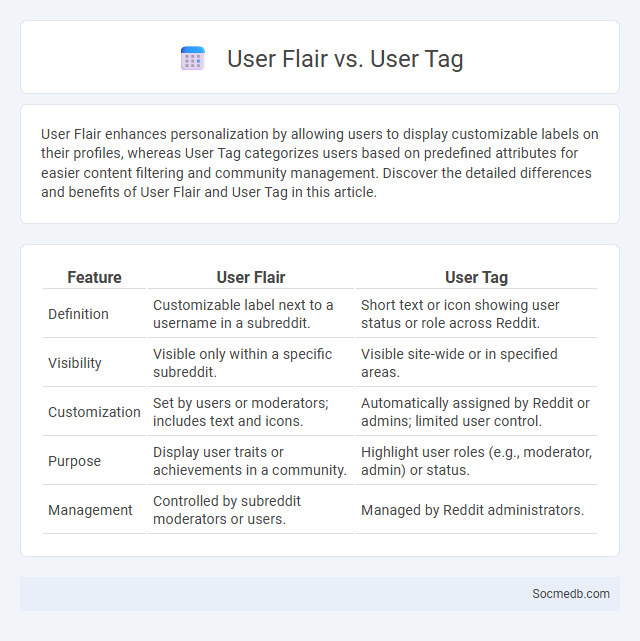
Photo illustration: User Flair vs User Tag
User Flair enhances personalization by allowing users to display customizable labels on their profiles, whereas User Tag categorizes users based on predefined attributes for easier content filtering and community management. Discover the detailed differences and benefits of User Flair and User Tag in this article.
Table of Comparison
| Feature | User Flair | User Tag |
|---|---|---|
| Definition | Customizable label next to a username in a subreddit. | Short text or icon showing user status or role across Reddit. |
| Visibility | Visible only within a specific subreddit. | Visible site-wide or in specified areas. |
| Customization | Set by users or moderators; includes text and icons. | Automatically assigned by Reddit or admins; limited user control. |
| Purpose | Display user traits or achievements in a community. | Highlight user roles (e.g., moderator, admin) or status. |
| Management | Controlled by subreddit moderators or users. | Managed by Reddit administrators. |
Understanding User Flair: Definition and Purpose
User flair on social media refers to personalized badges or labels displayed next to usernames that indicate specific attributes, roles, or achievements within a community. This feature enhances user identity and engagement by visually distinguishing members based on contributions, expertise, or preferences. Platforms like Reddit and Discord utilize user flair to foster a sense of belonging and to facilitate quicker recognition of user status or interests.
What is a User Tag? Key Characteristics
A user tag on social media is a feature that links a specific user's profile to a post, comment, or photo, enabling easy identification and interaction. Key characteristics include the ability to notify the tagged user, increase content visibility, and foster engagement by connecting related profiles. User tags often enhance networking and content discovery by allowing users to reference or highlight others seamlessly within the platform.
User Flair vs. User Tag: Semantic Differences
User Flair and User Tag serve distinct semantic purposes in social media contexts, with User Flair typically representing personalized badges or icons that reflect a user's identity or achievements within a community, enhancing visual recognition and social status. User Tags function as descriptors or metadata, categorizing users based on interests, roles, or content preferences to facilitate targeted interactions and content discovery. Understanding these semantic differences allows platforms to optimize user engagement by aligning visual identity (Flair) and functional categorization (Tag) efficiently.
Visual Representation: Flair and Tag Examples
Visual representation on social media hinges on the effective use of flair and tags, which boost content visibility and engagement. Custom flairs categorize posts, making your profile stand out while enhancing searchability through relevant hashtags that connect you to trending topics and niche communities. Crafting precise and appealing tags ensures that Your content reaches targeted audiences, maximizing interaction and growth potential.
Functional Roles: How Flairs and Tags Enhance User Profiles
Flairs and tags serve critical functional roles in social media by categorizing user profiles and facilitating content discovery. These elements enhance user interaction by allowing individuals to display interests, expertise, or affiliations, thereby improving personalized engagement and community building. Optimized use of flairs and tags increases visibility, driving targeted connections and fostering authentic social networking experiences.
Customization Options: User Flair vs User Tag
User flair and user tag both enhance personalization on social media platforms by allowing users to showcase identity and interests. User flair typically appears as a small badge or icon next to usernames, often customizable in color, text, or design to reflect group affiliation or achievements. User tags function as descriptive labels that categorize users based on skills, topics, or roles, improving content discoverability and targeted interaction within communities.
Moderation and Control: Setting Flairs and Tags
Setting flairs and tags on social media platforms enhances content moderation by categorizing posts for better visibility and organizing community discussions effectively. Your ability to assign specific flairs helps filter inappropriate content and maintain a respectful environment by enabling moderators to quickly flag and manage posts. These tools improve user engagement while ensuring compliance with platform guidelines and promoting a safer online space.
Community Engagement: Impact of Flairs and Tags
Flairs and tags play a crucial role in enhancing community engagement on social media platforms by categorizing content and making interactions more targeted and meaningful. They help users quickly identify relevant topics, foster niche communities, and stimulate discussions aligned with shared interests. Platforms like Reddit and Twitter utilize these features to boost user participation, increase content discoverability, and strengthen overall user cohesion.
Common Use Cases for User Flair and User Tag
User flair and user tags enhance social media engagement by allowing users to express identity and categorize content efficiently. Common use cases include highlighting expertise, showcasing achievements, or signaling group affiliation to build community trust. These features aid in content discovery and foster personalized interactions within platforms like Reddit, Twitter, and Discord.
Choosing the Right Identifier: Flair or Tag for Your Platform
Choosing the right identifier for your social media platform depends on user engagement goals and content organization. Flairs offer a structured way to categorize posts within communities, enhancing content discoverability and user interaction. Tags provide broader flexibility, allowing users to label content across platforms, improving searchability and trend tracking for your audience.
 socmedb.com
socmedb.com